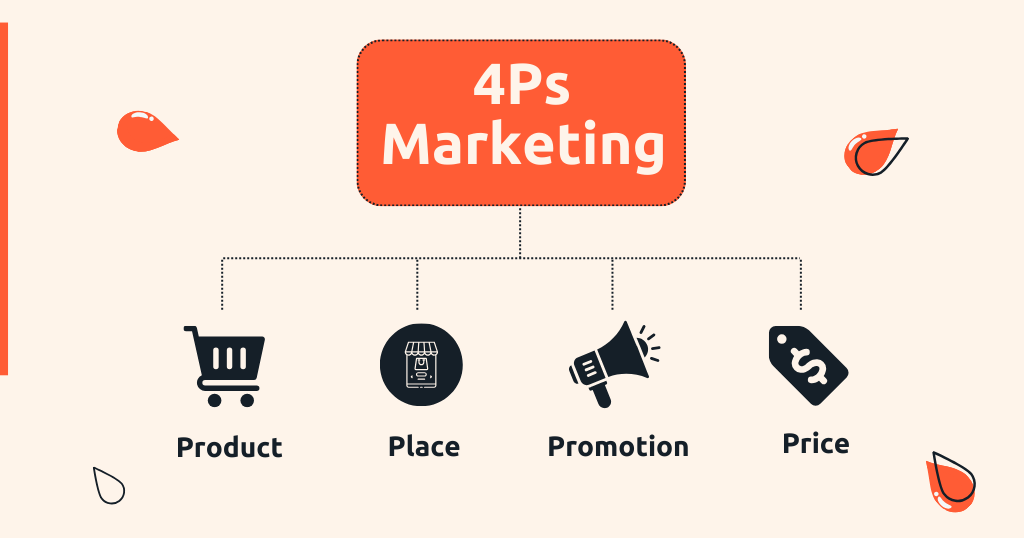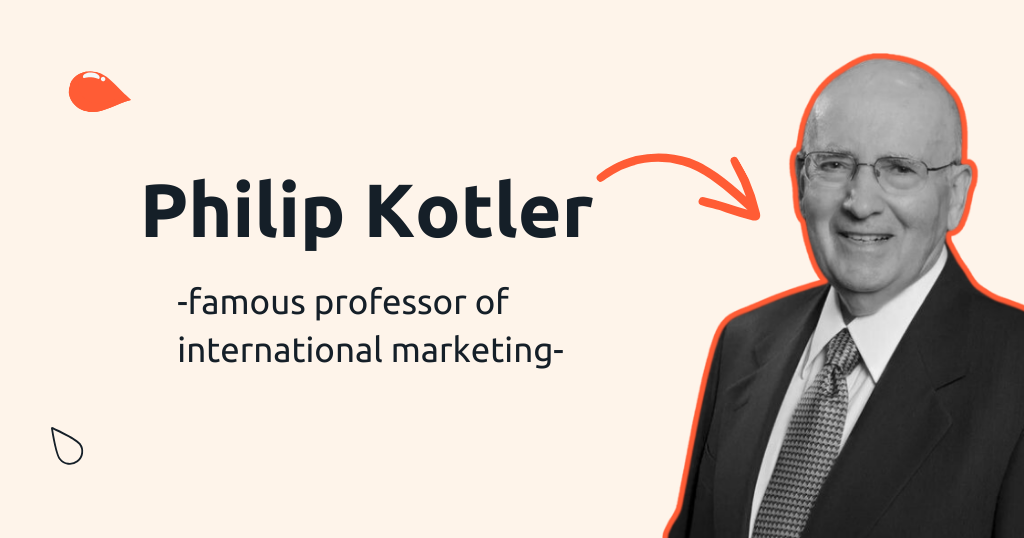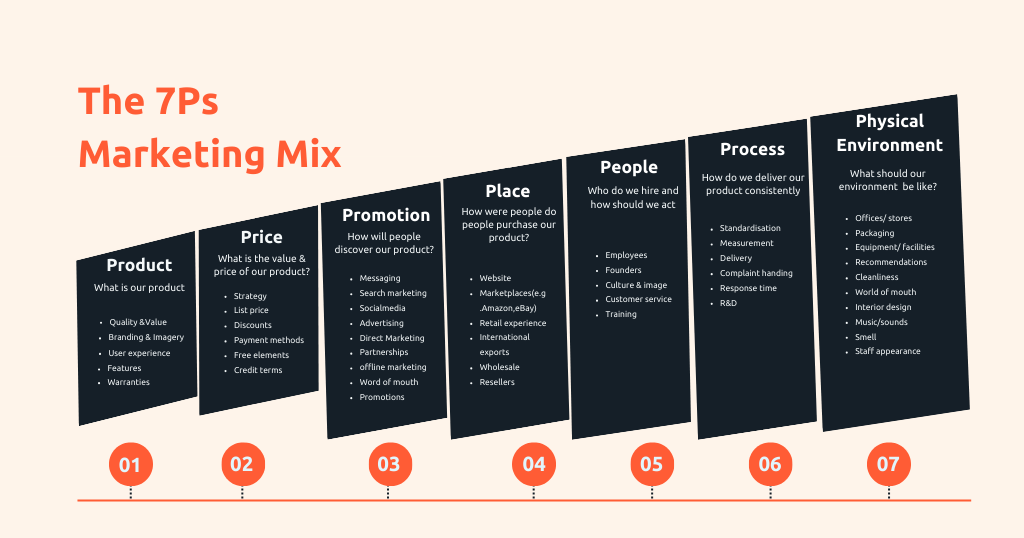Are any of you interested in learning how to utilize the marketing mix (often referred to as the 4Ps of marketing) to achieve the optimal combination of place, price, promotion, and product for your business? If so, Here we go.
Do you want to scale your business you need to have a successful marketing strategy. And we know that. But when you ask any marketing professional – what goes in my marketing strategy? They’re going to start listing various tactics they’ve learned.
- Consider hiring an influencer!
- Alternatively, ramp up your email campaigns!
- Focus more on organic social media growth!
However, those are techniques, not strategies. Before you even think about a marketing plan, there’s a crucial step that often gets overlooked, that is diving into the world of the marketing mix.
A marketing mix is a tool that can assist you in determining your target market, establishing objectives, and creating a strategy for achieving them.
A key component of company strategy is the marketing mix, also known as the 4 Ps framework. Understanding how the four components—product, pricing, place, and promotion—interact is essential if you want to build your business and draw in new clients.
Product, price, place, and promotion are the four Ps in a winning “marketing mix”
This framework supports to the companies to concentrate their marketing efforts on what’s important, make smarter business choices, and develop more effective marketing strategies. It assists brands in connecting with their target customers, defining their marketing goals, and enhancing product development and promotional strategies.
The marketing mix affects everything from product marketing, pricing strategy, promotional strategy, brand positioning, and all the various marketing efforts of a business.
✅ What is a marketing mix and why is it important?

The marketing mix is a collection of 4 or 7 components that specify a product or service’s marketing plan. With the use of the marketing mix, you can develop an effective marketing strategy that will improve your ability to reach your target market, increase product sales, and generate revenue.
This framework supports to the companies to concentrate their marketing efforts on what’s important, make smarter business choices, and develop more effective marketing strategies. It assists brands in connecting with their target customers, defining their marketing goals, and enhancing product development and promotional strategies.
The marketing mix affects everything from product marketing, pricing strategy, promotional strategy, brand positioning, and all the various marketing efforts of a business.
✅ What are the 4Ps of marketing?

The 4 Ps are:
- Product – What you’re selling, This is simply what you are offering for sale. It could range from physical items like electronics or clothing to services like consulting or housekeeping.
- Price – How much it costs, It’s all about the money, baby! This is the price you’re charging for your goods or service. You have to make sure it’s just right – not too high to scare people away, and not too low to make them believe it’s rubbish.
- Promotion – How people hear about your product (e.g., advertising), Think of this as spreading the message. How are you letting folks know about your fantastic products? You must spread the news in some way, whether through advertisements, social media, or good old-fashioned word-of-mouth.
- Place – Where people can buy it (e.g., stores, platforms), This is all about where customers can get their hands on your products. Do you sell in-store, online, or through a fancy app? Whatever the situation, you must make it easy for people to find and purchase what you’re selling.
Having a great marketing strategy is critical for success. The 4Ps of marketing (Product, Price, Place, and Promotion) are a tried-and-true structure. Businesses that properly use these factors can create comprehensive marketing plans that engage with their target demographic and generate growth. In this post, we’ll look at how you can use the four Ps to improve your marketing strategy and reach your business goals.
Let’s explore Advanced Marketing Tools to Elevate Your Strategy.
So, marketing is no longer just about selling products. If you run a service-based business, things are a little different. You must keep your attention on the people you are serving and ensure their satisfaction at all times.
Aside from the traditional four Ps, we have three more to consider: people, process, and physical evidence.
People: These are the members of your team who engage with customers. They are the face of your firm, so make sure they are pleasant and helpful.
Process: It’s all about how you do things. You want to ensure that your service delivery runs smoothly and efficiently, and that your consumers are pleased with how things are going.
Physical Evidence: Think of this as the environment where your customers and your team meet. It could be your office space, your website, or even your logo. You want everything to look professional and welcoming.
Let’s talk about the 4Ps in detailed:

Tip: Any successful marketing strategy should be revisited from time to time. The marketing mix you create is not intended to be static. It needs to be adjusted and refined as your product grows and your customer base changes.
Product: Marketing strategies revolve around the product or service being given. Understanding your product’s distinct features, benefits, and value proposition is critical for successfully presenting it in the market. Conducting market research to uncover consumer requirements and preferences will allow you to design your product to match their needs. Furthermore, ongoing innovation and improvement of your product based on client input helps assure its relevance and competitiveness in the market.
2. Place: Price influences consumer perceptions and purchase decisions. Setting the appropriate price for your product necessitates careful evaluation of a number of aspects, including production costs, rival pricing, and perceived value. Pricing research and analysis can help you find the best price point for maximizing profitability while remaining competitive in the market. Implementing pricing techniques such as discounts, bundling, or value-based pricing can also help to increase the perceived worth of your product and attract new customers.
3. Price: Price is the amount of money consumers pay for a product or service. In business, price is one of the most important elements of the marketing mix, alongside product, promotion and place. Price should be carefully managed because it’s often used as a way to communicate value and quality in your brand.
When setting prices for your products or services, you have to consider:
- How much does creating your product cost you?
- What does your competition charge for comparable products/services?
- Do they have higher or lower margins?
- Are there any gaps in pricing that would allow you to enter those spaces successfully? For each brand, pricing research is crucial because it helps decide how much to charge for a product. One way to gauge this is to monitor the prices of your competitors and contrast them with your own, taking into account product kind and seasonality.
4. Promotion: The process of communicating your product or service to your target market is called promotion. It’s the manner in which your branding strategy is used to convey your message through physical and digital media. It can take many different forms; to name a few, there is direct marketing, public relations, sales promotion, personal branding, and advertising.
✅ Understanding the Origin of the 4Ps of Marketing
The 4Ps were created by E. Jerome McCarthy in 1960 who presented them within a managerial approach in his book “Basic Marketing: A Managerial Approach“. The book covered things like analysis, consumer behavior, market research, market segmentation, and planning. Philip Kotler popularized the approach and helped spread the 4Ps model.
There are several other approaches in marketing that are just as powerful and effective if you apply them correctly. First, let’s talk about the 5 Ps.
✅ 5 P’s of Marketing – Learn More About the Marketing Mix
Philip Kotler, a famous professor of international marketing at Northwestern University’s Kellogg School of Management, created this paradigm. He is also credited with making the marketing mix definition more widely accepted.
So, when we talk about the “people” part of the 5P’s, we’re really diving into the vibe, the service, how the employees carry themselves, and the whole experience they create. Think about it – whether you’re dealing with a service or buying a product, how the folks representing that company act and treat you can make a huge difference, right? It’s like the heart and soul of the business vibe.
✅ How did the 5Ps become the 7Ps of marketing?
The 5 Ps of marketing worked for a while, but marketers eventually realized that the model did not cover all of the factors. In 1981, Booms and Bitner developed a 7-Ps model that included the original four aspects as well as three additional ones: people, process, and physical evidence (or physical environment).
✅ What are the 7Ps of marketing?
The 7Ps are known as the extended marketing mix and they are:
- Product – Your product or service.
- Price – How much you will charge for the product or service.
- Place – Where you will sell your product or service (e.g., online, in a physical store).
- Promotion – The way you advertise your products to get customers interested in buying them (e.g., social media posts and billboards).
- People – The people who work for you, including managers and employees of your business (also known as stakeholders).
- Process – Processes and systems that help run your business smoothly (often referred to as operations).
- Physical evidence – the physical place where your brand exists (a store) or the environment where the actual purchase takes place.
✅ 7 Principles of Customer Service You Should Follow
There is an alternative approach to the 4 Ps that was suggested by Peter Bowman in his book “Service 7”. Bowman created something called the seven service marketing principles which include – value, business development, reputation, customer service, and service design. This framework is widely used in Australia.
✅ What are the 4 C model of marketing
Another prominent framework is known as the 4Cs of marketing, which stand for consumer, cost, convenience, and communication.
- Consumer – Rather than focusing on the product, this approach concentrates on the consumer. This is where the brand would define their ideal consumer profile and devise successful marketing methods to develop and promote a product that addresses their difficulty.
- Cost – Price is simply one element of the issue, and this approach considers the total cost of meeting a customer’s need. This could include the cost of time spent procuring the product, the cost of conscience from consuming it, and the cost of not choosing the competitor’s product.
- Convenience – Brands are not confined to physical channels, and they may use a variety of channels in their digital marketing mix. These may include the product’s numerous platforms, digital stores, social media networks, and online distribution channels.
- Communication – This final category shows a greater focus on the brand’s marketing tools and channels for communicating with customers. This could involve display commercials, public relations, personal selling, direct marketing, influencer marketing, and many other things.
Wrap Up!
The marketing mix is undeniably pivotal in driving business growth and maximizing ROI. While the traditional 7Ps framework remains invaluable, its applicability may vary across different business contexts. Before embarking on any marketing endeavor, it’s imperative to grasp the intricacies of your target audience. Tailoring your marketing strategy to meet their needs ensures relevance and effectiveness.
Now, let’s delve into the marketing mix. While it’s a valuable tool, it’s essential to acknowledge its limitations. Understanding your audience is paramount; without this insight, crafting a compelling marketing strategy becomes challenging. At Prime One Global, we recognize the complexities of navigating the marketing landscape. If you find yourself grappling with your marketing mix, fear not! Our experts are on hand to provide a Free Consultation and help refine your approach. Let’s collaborate to elevate your marketing strategy to new heights of success!







